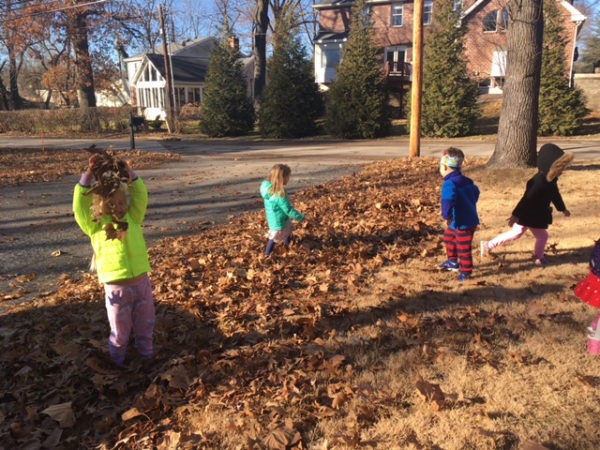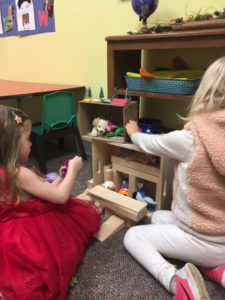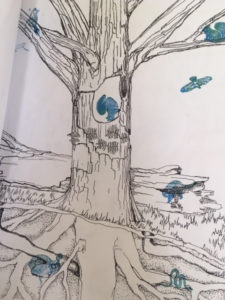Post submitted by Erin Guenther, Sow & Grow Preschool
 The students in the Sprouts class at Sow & Grow Christian Preschool spent weeks exploring how animals and people live in the winter, how they stay warm, how they find food and where they live. We extended this to an outdoor lesson by going outside and piling up leaves for small animals and spiders to live under. They got really into this and wanted to include blankets and pillows. Some students overcame their fear of the insects out of concern if the “creepy things” would be able to stay warm. Back in the classroom students used wooden blocks, cardboard boxes and pretend food (they wanted animals to have food nearby) to build homes for our toy animals.
The students in the Sprouts class at Sow & Grow Christian Preschool spent weeks exploring how animals and people live in the winter, how they stay warm, how they find food and where they live. We extended this to an outdoor lesson by going outside and piling up leaves for small animals and spiders to live under. They got really into this and wanted to include blankets and pillows. Some students overcame their fear of the insects out of concern if the “creepy things” would be able to stay warm. Back in the classroom students used wooden blocks, cardboard boxes and pretend food (they wanted animals to have food nearby) to build homes for our toy animals.
 Outside we looked under tree bark and tree stumps to find insects living there. We were delighted to find roly polies, crickets and spiders. “He’s missing a leg and moving slow!” One of the students noticed the cricket was missing a leg and we talked about how that could have happened and how it affects the cricket. There was a lot of empathy and problem solving as they thought of ways to give the cricket a new leg.
Outside we looked under tree bark and tree stumps to find insects living there. We were delighted to find roly polies, crickets and spiders. “He’s missing a leg and moving slow!” One of the students noticed the cricket was missing a leg and we talked about how that could have happened and how it affects the cricket. There was a lot of empathy and problem solving as they thought of ways to give the cricket a new leg.
 Back in class we read “Over and Under the Snow”, “Under the Snow” and “Animals in Winter”. Using pieces of brown and white butcher paper and pictures of real animals (thank you to MDC) the students taped the animal either above the snow (white paper) or under the snow (brown paper) depending on where it lives during the winter. We read “Tracks in the Snow” and made our own animals tracks and people paw prints to take home. Thanks to our winter visit to LREC the students saw real animals tracks alongside the creek. We borrowed stamps of animals and their tracks from LREC to make pages for our animals and people in winter books.
Back in class we read “Over and Under the Snow”, “Under the Snow” and “Animals in Winter”. Using pieces of brown and white butcher paper and pictures of real animals (thank you to MDC) the students taped the animal either above the snow (white paper) or under the snow (brown paper) depending on where it lives during the winter. We read “Tracks in the Snow” and made our own animals tracks and people paw prints to take home. Thanks to our winter visit to LREC the students saw real animals tracks alongside the creek. We borrowed stamps of animals and their tracks from LREC to make pages for our animals and people in winter books.
The students often play hibernation or pretend to burrow during their open play and are continuously using plastic animals to make tracks in the playdough.